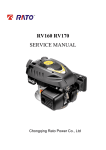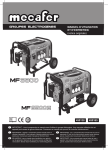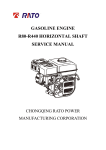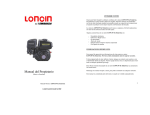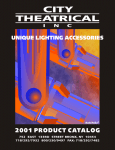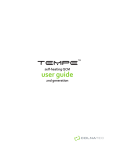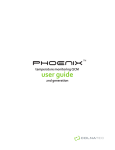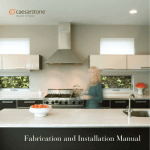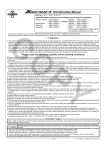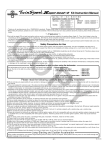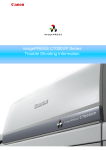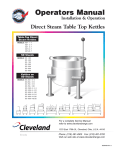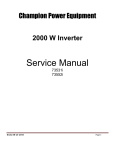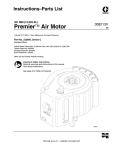Download Owners Manual
Transcript
General Power Products Portable Electric Generator Service Manual Model: APP 6000 Contents Chapter 1 General Information…………………………………………….. 3-7 General Description of Generator…………………………………. 3 Safety Information…………………………………………………… 4 Model Parameters…………………………...………………………. 5 Maintenance and Adjusting Data……………..……………………. 5-7 Chapter 2 Maintenance of the Generator Set………………………………8 2.1 Maintenance of Starting System……………………………….. 8-10 2.2 Maintenance of Lubrication System…………………………… 10-11 2.3 Maintenance of Inlet System…………………………………… 12-13 2.4 Maintenance of Fuel System………………..………………… 13-14 2.5 Maintenance of Exhaust System……………………………… 14-15 2.6 Maintenance of Ignition System……………………………….. 16-17 2.7 Maintenance of Generator………………………………………18-20 2.8 Maintenance of Cylinder Head and Valve……………………. 20-24 2.9 Maintenance of Crankcase, Crankshaft and Camshaft……... 25-28 2.10 Maintenance of Connecting Rod, Piston and Cylinder…….. 29-31 2.11 Electrical System ………...................................................... 32 2.12 Wiring Diagram…………………………………………………. 33 Chapter 3 Trouble Shooting…................................................................. 34 3.1 General…………………………………………………………… 34 3.2 Hard Starting…………………………………………………….. 35 3.3 Ignition System……………………………………………………35 3.4 Generator Power Flow Chart…………………………………… 36 3.5 Electrical Troubleshooting Stator……………………………… 37 3.6 General Troubleshooting……………………………………….. 38 Chapter 4 Exploded View and Bill of Materials (BOM)………………….. 39 4.1 Exploded Views………………………………………………… 39-42 4.2 Bill of Materials (BOM)………………………………………….. 42-50 2 Chapter 1 General Information APP 6000 Generator is equipped with a single cylinder, 4 stroke, forced air-cooled, OHV 25° slant, internal combustion engine. It is equipped with an electronic ignition system and is tuned to meet all EPA and California Emissions Requirements. Figure 1.1 General Description: 1. Gas Tank 2. Choke 3. Fuel Shut Off 4. Pull Starter 5. Oil Dipstick 6. 120 Volt Outlet 7. Ground 8. Circuit Breaker 9. On Off Switch 10. Gas Cap 11. Gas Tank 12. Valve Cover 13. Air Filter 14. Frame 15. Muffler 16. 3 Safety Information: This symbol is known as the safety alert symbol and points out safety instructions that can lead to injury or death. Attention: Please read and understand this manual and the safety information prior to starting the Generator. Danger: Indicates an imminently hazardous situation which, if not avoided, will result in death or serious injury. Warning: Indicates a potentially hazardous situation which, if not avoided, could result in death or serious injury. Caution: Indicates a potentially hazardous situation which, if not avoided, may result in minor or moderate injury. SAFETY INSTRUCTIONS This generator is designed to supply electrical power. Please read and understand all of the safety instructions and warning labels associated with this generator. 1) 2) 3) 4) 5) Do not operate indoors. Generator must be on a flat stable surface. Surface slope not to exceed 4 degrees. Operate in a well-lit and ventilated area. Do not operate in moist or wet conditions including the surrounding ground. The generator should be a minimum of 3 feet away from all combustible materials and should not be used around hazardous materials. 6) Operating at a gas or natural gas filling station is forbidden. 7) Do not touch muffler or cylinder during or after operation. They are hot. 8) No smoking when filling the gas tank. 9) Do not overflow gas tank. Fill the tank to 1 inch below the top neck to allow for gas expansion. Ensure the ventilation hole in the gas cap is not plugged with foreign matter such as dirt or leaves. 10) The engine should be shut off for at least 2 minutes before adding gas or oil. 11) Do not open the gas tank or oil reservoir while the engine is running. 12) Be mindful of the danger, warning and caution labels on the generator. 13) Keep away from children. Children should be kept at a minimum of 6 feet away from the generator at all times. 14) In a normal situation the generator should be shut off using the instructions found on the front panel label. 4 Models / Parameters APP 6000 Dimension/Weight Engine APP6000 Model OHV13H LxHxW - Inches 26.8x20x21.3 Engine Type 4-stroke, overhead valve, cylinder tilt 25° Net Weight, Box Incl. 185lb Cylinder discharge capacity 389 cc Gross Weight, Full of Fuel 220lb Bore x Stroke 88x64 mm Cooling System Forced Air Cooling APP6000 Ignition System Transistor Magnet Ignition Rated Voltage 120V / 240V Spark Plug NGK, BP6ES Rated Frequency 60HZ Engine Oil Volume 1.1Qt Rated Current 27.2A Fuel Volume) 6.6 Gallon Rated Output 6.0KW Compression Ratio 8.0:1 Max Output 6.3KW Model Generator A.C. Output Model Maintenance and Adjusting Data Tolerance Parameters Parts Item Max Speed Engine Cylinder Pressure Cylinder Cylinder head Cylinder bore diameter Warpage Valve bushing Outside Diameter of piston skirt Gap of piston and cylinder Piston Inside diameter of piston pin hole Outside diameter of piston pin Clearance of piston and piston pin hole Flank clearance of Piston ring Closed gap of the first and second ring Piston Ring Closed gap of the oil ring Width of the first ring Width of the oil ring Small end diameter Connecting Rod Large end diameter Large end clearance Large end flank clearance Crankshaft Standard 3750+ 150, No Load 588834KPa@600RPM 85-120PSI@600PSI 88.00mm, 3.465" Crankshaft pin outside diameter 6.60mm, .260" 87.985mm, 3.464" .015-.052mm, .001" 20.002mm, .787" 20.00mm, .787" .002-.014mm, .0006" .030-.060mm, .002" .20-.40mm, .012" .20-.70mm, .002" 2.0mm, .079" 2.8mm, .110" 20.005mm, .7876" 36.025mm, 1.418" .040-.066mm, .002" .1-.7mm, .019" 35.985mm, 1.4167" Extreme Max/Min 88.17mm, 3.471" .10mm, .004" 6.75mm, .2657" 87.85mm, 3.459" .12mm, .005" 20.042mm, .789" 19.95mm, .785" .08mm, .003" .15mm, .006" 1.0mm, .039" 1.0mm, .039" 1.75mm, .069" 2.7mm, .106" 20.07mm, .790" 36.070mm, 1.420" .12mm. .005" 1.0mm, .039" 35.93mm, 1.4146" 5 Intake valve adjusted clearance Exhaust valve adjusted clearance Intake valve stem diameter Exhaust valve stem diameter Valve Valve guide inside diameter Clearance of intake valve and guide Clearance of exhaust valve and guide Valve seat width Spring free length Intake valve cam height Camshaft Exhaust valve cam height Camshaft collar Crankshaft case cover Camshaft hole spark plug Spark plug gap spark plug capacity Resistance Resistance of primary coil Ignition Coil Resistance of secondary coil Air Gap .15+.02mm, .006+.001" .20+.02mm, .008+.001" 6.59mm, .259" 6.55mm, .258" 6.60mm, .260" .010-.037mm, .001" .050-.077mm, .002" 1.1mm, .043" 39.0mm, 1.535" 32.44-32.60mm, 1.279" 31.94-32.10mm, 1.260" 15.984mm, .6292" 16.0mm, .6299" 0.7-0.8mm, .027.031" 7.5-12.5K ohms .8-1.0 ohms 5.9-7.5 ohms .4+.2mm, .016+.007" 6.44mm, .253" 6.40mm, .252" 6.66mm, .262" .10mm, .004" .12mm, .005" 2.0mm, .079" 37.5mm, 1.476" 32.24mm, 1.269" 31.74mm, 1.249" 15.92mm, .6268" 16.05mm, .6318" Torque Values Torque Item Size N/m Torque in*lbf *except where note 124 300 *83 ft*lbf 88 212 88 Fuel switch connecting nut M10X1.25 14 34 113 10 24 10 Exhaust pipe connecting nut/bolt M8X1.25 24 212 Air filter bolts M6X1.0 Air filter nut M6X1.0 7.5 8.5 23 44 66 75 203 389 Connecting rod bolt Cylinder head bolt Flywheel nut M8X1.25(special bolt) M10X1.25 M16X1.5(special nut) Rocker shaft nut M6X.5 Rocker shaft bolt M8X1.25(special bolt) Drain plug M12X1.25 Rotor bolt M10X210 6 Standard Torque Values M5 M6 Bolt and nut M8 M10 M12 M6 M8 Flange bolt and flange nut M10 M12 M5 Screw M6 5 10 24 37 55 12 26 34 59 4 9 44 88 212 327 487 106 230 300 522 35 79 Fitting Directions: 1. When fitting the piston in the cylinder the mark “ ” on the piston top must be aimed to the intake valve direction (upper). 2. When fitting the piston rings on the piston the “R,N’ mark on the first and second ring must be upwards, and the gap of all three rings should be 120° apart. 3. The timing marks on the gears must be matched to each other. Generator Information Area Main Winding Field Winding Exciter Winding Main Winding Carbon Brush length Item Resistance Resistance Resistance Resistance Length Standard .2 ohms 52-62 ohms 1.2 ohms .4 ohms .9mm, .354" Service Limit 5mm, .197" EPA and Engine Serial Number are located on the panel side of the generator in the location shown. 7 Chapter 2 Maintenance of the Generator Set 2.1 Maintenance of the Manual Starting System The integral configuration of the starting device is shown below. Check the condition of the starter. Replace if damaged. There is a spring inside the starter device that is under stress. Wear safety goggles and watch for flying debris when it is removed. Remove the perimeter bolts to remove the starter housing. 8 Check the condition of the starter system. Replace any broken or damaged parts as follows: 1. 2. 3. 4. Inspect the rope for abrasions. Replace as necessary. Dismantle the starter pawl guide bolt with a socket. Remove the pawls and pawl spring. Visually inspect all parts. 9 5. Inspect the flute of the starting draw wheel. 6. Remove the shroud from the engine for inspection of the fan blades. 7. Replace parts as necessary. 10 2.2 Maintenance of the Lubrication System Chose the oil type according to the local temperature of operation. Use Four-stroke engine oil. SE, SF or equivalent to SG grade oil (SAE-30). When temp is below 50qF SAE 10W30 is recommended. SAE 5W-30 is recommended when temp is below 5qF. 1. It is best to change the engine oil when the engine is warm. This allows the oil to flow better for a complete drain. 2. Drain the oil from the cylinder block by removing the plug at the base of the engine. 3. Check the condition of the dipstick and o-ring seal. 4. Replace the drain plug. 5. Fill with oil. See specifications in section 1.1 (parameters) for amount to add. 11 2.3 Maintenance of the Inlet system 1. Remove the air cleaner outer cover by releasing the latches at the top and bottom. 2. Remove the air cleaner element (foam pad). Replace as necessary. Never use gasoline, low-burning point solvent, acid or alkaline to clean the element. Use detergent only! Cleaning the element (foam pad) Dip the element in the detergent and wring it out. Apply motor oil and wring out excess oil. Install element. 3. Remove the plastic inner housing by removing the six nuts around the perimeter. 12 4. Remove the enclosure by removing the two nuts inside the enclosure and one on the backside. 5. Remove the carburetor gasket and choke mechanism. Some models may not have automatic chokes and the choke mechanism will not need to be removed. It is built onto the carburetor in this case. 6. Remove the lines to the carburetor and remove the carburetor. 2.4 Maintenance of Fuel System 1. Remove the bowl of the fuel cock. 2. Remove the screen inside the fuel cock. 3. Remove the fuel cock. 13 4. Pull out the screen inside the tank. 5. Clean or replace both screens and reassemble. 2.5 Maintenance of the Exhaust System 1. 2. 3. 4. Remove the outer heat shield from the muffler. Bend the anti-rotation tabs back around the engine exhaust bolts. Remove the bolts from the engine side of the exhaust pipe. Remove the two bolts from the muffler to the generator head to separate the muffler from the generator. 5. Lift the muffler out of the frame and inspect for cracks. 6. Inspect the spark arrestor mounted over the outlet of the muffler. It should be clear of debris and have no tears in the screen. 7. Replace the muffler or spark arrestor as necessary. 14 8. Inspect the gasket between the muffler and the engine head. 9. Inspect the engine head for carbon build up. Too much build up in the head or muffler can rob the engine of power. 15 2.6 Maintenance of the Ignition System 1. Check the gap between the ignition coil and the flywheel. The gap should be 0.4mm + 0.2mm, .016” + .007”. 2. Check the status of the spark from the ignition coil. It should be a blue spark and must be above 10,000 Volts. 3. When there is no output voltage from the ignition coil, remove the coil by removing the bolts that hold the ignition coil to the engine block. 4. Remove the spark plug cap and unplug the other wires so the ignition coil can be removed. 5. Using a multi-meter capable of measuring resistance or an ohmmeter, connect one end of the tester to the spark plug lead. Connect the other end to the core of the ignition coil. Resistance value of the secondary end of the coil is 2.5K to 2.8K ohms. 16 6. Connect one end of the ohmmeter to the primary (small black wire) lead, the other end to the core of the ignition coil (same location as before). The resistance value of the primary coil is .25 to .30 ohms. 7. Replace as necessary. 8. Remove the spark plug. Check the cylinder pressure. Is should fall in the values noted in section 1.1 of this manual. If the plug is brown in color the engine is working normally. 9. Check for carbon build up on the spark plug. Check the gap of the spark plug. The values for the gap are found in section 1.1 of this manual. 10. Remove the flywheel. Use a screwdriver to hold the flywheel from moving while unloosening the flywheel nut. The torque value of the nut is 113N*m or 83 ft*lb. 11. Remove the flywheel by using a gear puller. 12. Check for any damage to the flywheel. Rust can me remove from the magnet section by light sanding. 17 2.7 Maintenance of the Generator 1. Remove the two bolts on the rear cover of the generator head. 2. Remove the main bolt in the center of the rotor. Check the bearing. 3. Remove the screws on the outside of the generator head housing. 4. Remove the AVR (large plastic part with wires coming out) Automatic Voltage Regulator. 18 5. Remove the bolts in the brushes, and remove the brushes. 6. Remove the mounting nuts from the rubber engine and generator head mounts. There are four total, two under the engine and two under the generator head. This will allow you to lift the engine generator combination out of the frame. 7. Remove the rear housing from the generator as shown. 8. Remove the stator cover. 9. Remove the generator stator. 10. Check the stator and rotor for damage or burnt wires. If there are any contact marks or wires that have burnt or the insulation is melted, replace the parts. 19 11. To remove the rotor from the engine install the bolt that came out of the shaft center. Screw it in until only ¼” is left until the head comes in contact with the bearing. 12. Forcefully strike the screw with a large blacksmith hammer to remove the rotor from the engine. 2.8 Maintenance of the Cylinder Head and Valve 1. Remove the spark plug. 2. Remove the valve cover head bolt located in the center of the valve cover. 3. Check the gasket of the cover. Check the condition of the valve cover gasket. 4. Check the valve clearance of the engine. If they have to be adjusted loosen the valve adjustment nut and then adjust the clearance. a. Clearance for intake .15mm + .02mm, .006” + .001” b. Clearance for exhaust valve .20mm + .02mm, .008” + .001”. 20 5. Tighten the nut with the following torque: a. Adjustment nut 10 N*m, 88 in*lbf b. Tightening nut 10 N*m. 88 in*lbf 6. Remove the rocker arm for inspection. 7. Remove the lifters and inspect. Rolling them on a flat surface will help to check if they are bent. 8. Remove the rocker arm bolts so you can remove the rocker arm guide plate and inspect the plastic inserts in the plate for damage. a. Torque of the rocker arm bolt is 24N*m, 210 in*lbf 9. Inspect the flute and the protruding parts of the rocker arm. 10. Remove the four head bolts. When tightening the 4 head bolts use an across the head sequence. a. Torque of the head bolts is 34N*m, 300 in*lbf 21 11. Remove the head and inspect the head gasket. Sometimes the head may need a tap up with a plastic hammer. Never use a screwdriver between the head and the cylinder or you will damage the surface. 12. Remove the alignment pins. 13. Fill the inlet and exhaust with cleaning fluid from the parts washer and look for leaks around the valves. If there are leaks the valves will need to be lapped and inspected. 14. Clean the carbon deposits off the head. Do not gouge the head surface this will cause a hot spot and melt the head. 22 Make sure you have on your eye protection. 15. Remove the spring retainer clips from the valve springs. Holding the valve up and using a pair of pliers push down on the retainer. At the same time slide the retainer towards the larger hole and slowly let the retainer up. It should slide off the valve stem. 16. Inspect the valve guide inner diameters. The value for the diameter is listed in section 1.1 tolerance parameters table. Never reuse the guides after they have been pressed out. 17. Inspect the valve seats. Use a vernier caliper to measure the width of the inlet and exhaust valve seat. a. Width of seat: std value 1.1mm up to 2.0mm, .043” to .079” 23 18. Inspect the valve spring free height. The values are found in section 1.1 tolerance parameters table. 19. Inspect the valve stem diameter. 20. Measure the distortion value of the valve stem end with a micrometer following the 1 and 2 position in the figure. Replace the valve and valve guide if the distortion value is over the limit of maintenance. a. Inlet valve .12mm, .005” b. Exhaust valve .16mm, .007” 21. Inspect the valve seat area as shown. a. Width of valve end surface 2.0mm, .079” max 24 2.9 Maintenance of the Crankcase, Crankshaft and Camshaft 1. Make sure all the oil is drained from the crankcase. 2. Remove the flange mounting bolts. See section 1.1 standard torque values. 3. Remove the crankcase cover. Slight tapping with a plastic hammer may be required. Never use a screwdriver between the cover and the crankcase or you will damage the sealing surface. 4. Remove all residue of the gasket. Use a new gasket when reassembling. 5. Inspect the crankcase cover and crank bearing area for cracks or unusual wear. The values for the diameters can be found in section 1.1. 6. Replace the crankcase cover oil seal as necessary. 25 7. Inspect the crankshaft and camshaft gears. Worn or damaged gears will need to be replaced. 8. Remove the locking pin from the governor shaft. 9. Remove the governor shaft. 10. Note the marks on the gears. They should line up with each other. Remember this for assembly. 11. Remove the camshaft. 12. Remove the rod bolts. a. Torque value 14N*m, 125 in*lbf 26 13. Remove the connecting rod cap and inspect for damage. See section 1.1 for clearance values. 14. Remove the lifters and inspect. 15. Remove the crankshaft and inspect for damage. 16. Clean the crankcase and inspect for cracks and damage. The diameters can be found in section 1.1. 17. Remove the bolt in the governor gear center and remove the governor gear. Inspect for damage. 27 18. Inspect the tappet surface for scratches. Both the diameter and the surface the cam rides on. 19. Inspect the cam lobes. Replace the cam if the value is lower than the minimum values. a. Height for both intake and exhaust minimum is 31.35mm, 1.234” 20. Check the cam journals. a. Minimum is 15.92mm, .627” 21. Check the MCR (manual compression release). It should be free to move and the spring should easily return it to position. 22. Inspect the crankshaft rod journal. a. Diameter should be a minimum of 32.92mm, 1.2960 28 2.10 Maintenance of the Connecting Rod, Piston and Cylinder 1. Remove the piston from the cylinder. Remove the carbon deposits from the top of the piston. 2. Inspect the inner wall of the cylinder for damage. The values for the diameter can be found in section 1.1 table. Remember to measure the diameter in at least three different locations, for instance, top, middle and bottom. 3. Measure the side clearance of the piston ring with the cylinder with a feeler gauge. This value is shown as the flank clearance in the table in section 1.1. 4. Place the piston rings in the cylinder and measure the gap. 5. With the piston rings removed, put the piston in the cylinder and measure the terminal clearance. Replace the piston or rings as necessary. 6. Remove the piston retaining rings for inspection. 7. Remove the piston pin and inspect. 8. Remove the connecting rod. The limits can be found in section 1.1 table. 29 9. Measure the piston pin. 10. Inspect the rod end cap. 11. Burnish the piston top with 400 granular sandpaper. Remove the carbon deposits of the piston ring slots with a non-metal tool taking care not to scratch the piston. 12. Measure the outside diameter of the piston pin with a micrometer. The value can be found in section 1.1 table. 13. Check whether the piston rings are scared or the elasticity is weak. Replace as necessary. 14. Measure the piston ring slot. Inspect for abrasion on the piston. Replace if the value is greater than the value found in section 1.1 table. 30 15. Measure the external diameter of the piston skirt. 16. When installing the piston rings all the gaps should be staggered 120° apart. 31 2.11 Electrical System 1. Remove the panel of the generator 2. Remove the screws in the plastic panel enclosure. 3. Push in at the clip location, not the screw location, to remove the plastic panel 4. Replace outlets or switches if there is any damage. Replace any wires that may be burnt. Burnt wires are usually from loose terminals. See trouble shooting section for more information. 32 2.12 Wiring Diagram 33 Chapter 3 Defect Analysis and Troubleshooting 3.1 General Ignition Coil: 1) Check Air Gap 2) Faulty Hard Starting Carburetor: 1) Dirty 2) Linkage Spark Plug: 1) Faulty 2) Gap Will not go high speed Governor Adjustment Valve 1) Clearance Adjustment 2) Seat Sealing Problems 3) Valve Train Issues Lacks Power Cylinder: 1) Piston Wear 2) Ring Wear 3) Cylinder Wear 34 3.2 Hard Starting Fuel Fill Fuel Spark Plug 1) Wet 2) Dry Ignition: 1) Bad Spark Plug 2) Air Gap of Coil 3) Flooded, carburetor bowl 4) Bad Coil 5) Compression 6) Valve Clearance Blockage: 1) Carburetor 2) Fuel Line 3.3 Ignition System Switch is ON Will Not Start No Spark: 1) Plug Bad 2) Gap 3) Switch Bad, disconnect the black wire from the engine switch, if it still does not work a. Coil Defective b. Air gap of coil Spark Test x x x Never hold the plug wire when wet. There is no fuel present. Do not test near the plug hole to avoid fire hazards. 1) Remove the plug and ground the electrode against the engine with the cap attached. 2) Turn on the engine switch and pull the recoil. Spark should jump across the electrodes. 35 3.4 Generator Power Flow Chart Low/NO Voltage Brush Voltage Running: 22.5V DC + 4V, between (1) and (2) Engine RPM 1) Governor 2) 3750 no load AC Voltage at Terminals 1) 120 V between (3) and (4) 2) 120 V between (5) and (6) Electrical Panel Wires: 1) Broken 2) Loose Brush/Rotor 1) Clean Brushes 2) Check Rotor resistance between slip rings 52-62 ohms, brushes disconnected 3) If fails replace rotor, check brush voltage again 12 Volt battery test 36 3.5 Electrical Troubleshooting Stator 12 Volt Battery Test of Stator Remove the AVR and connect a 12 volt battery to the brush terminals. Make sure the positive and negative terminals are correctly wired. Run the generator at full speed 3750 RPM no load. Follow the chart below: 12 Volt Batter Test for Stator Troubleshooting Location Main 1 Main 2 Exciter Sensor Brushes Point Number (3) and (4) (5) and (6) (7) and (8) (10) and (11) (1) and (2) Specified Voltage 59 VAC + 5 59 VAC + 5 56 VAC + 3 8 VAC + 1 12 VDC Voltage Variance low low low low/high Component Replacement Stator Stator Stator Stator Battery Problem It is unlikely but not impossible for all the windings to test low. If all windings test low check the rotor resistance, engine RPM and battery voltage again to make sure these are not the problem. 37 3.6 General Troubleshooting Problem Cause Defective ignition system Air cleaner is dirty Air leak from the engine Air leakage from filter Carbon deposits on spark plug Improper spark plug gap Spark plug insulator The Damaged ignition coil Generator No spark or light spark of plug starts hard or will not start Plugged fuel filter Dirty carburetor Air leakage from cylinder head gasket Valve seat leakage Valve spring weak Valve setting not correct Piston and piston rings worn Too much carbon on piston and head Crankshaft is damaged Camshaft wear Rocker arm wear Engine Speed Connecting rod wear is unstable Piston pin wear Valve shaft worn Valve seat leaking Forced cooling fan is broken Too low on oil Old oil Engine is overheating Piston oil ring damaged Dirt in the fins Dirt in the shroud Stator interferes with rotor Generator getting hot Cooling fan of generator broken Breaker damaged The Generator set Load is unstable Voltage is not as stated No voltage Abnormal noise Correction Inspect the electrical parts of the ignition system Clean element Check hoses for leaks Check filter Clean or replace the plug Check gap Replace plug Replace ignition coil Replace plug Clean filter Clean Carburetor Replace gasket Grind valves Replace springs Set the valve clearance Replace piston and rings Remove carbon Replace Replace Replace Check and replace Check and replace Check and replace Check valve and grind if necessary Replace fan Change and fill Change and replace Replace Clean Remove shroud and clean Replace stator and rotor Replace bearing Replace fan Inspect and replace Replace AVR Replace AVR Replace brushes Replace bearing or tighten center bolt 38






































